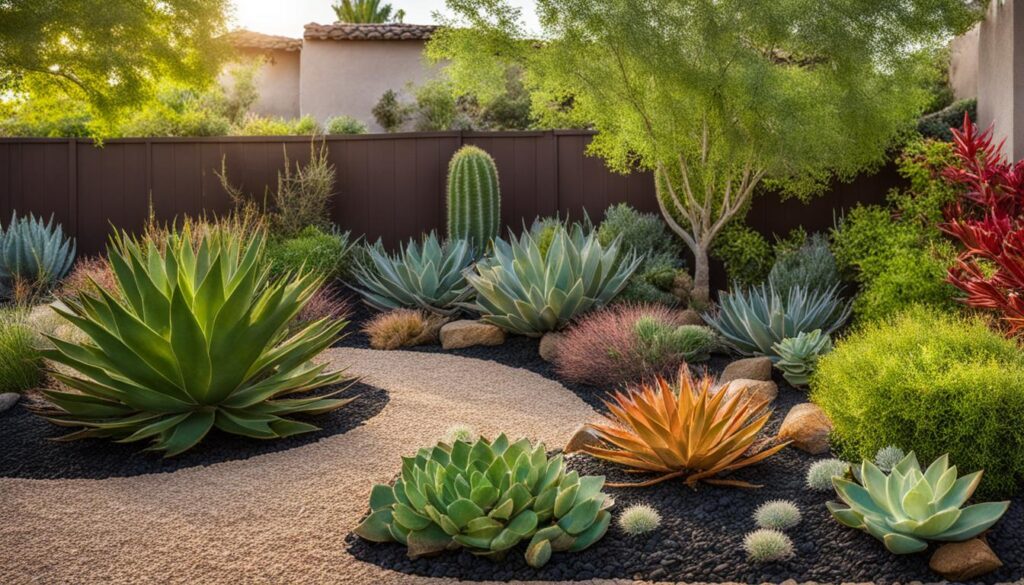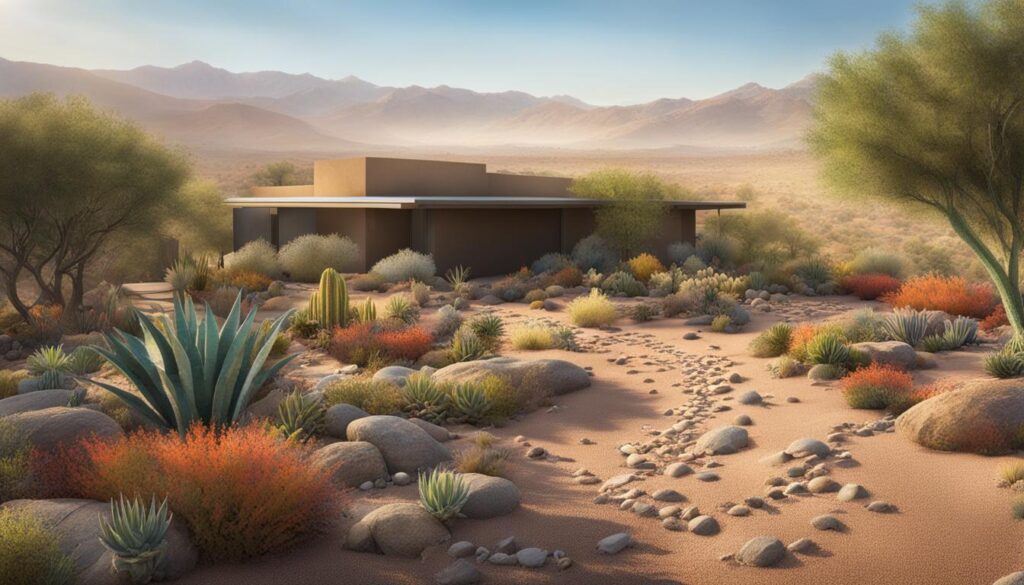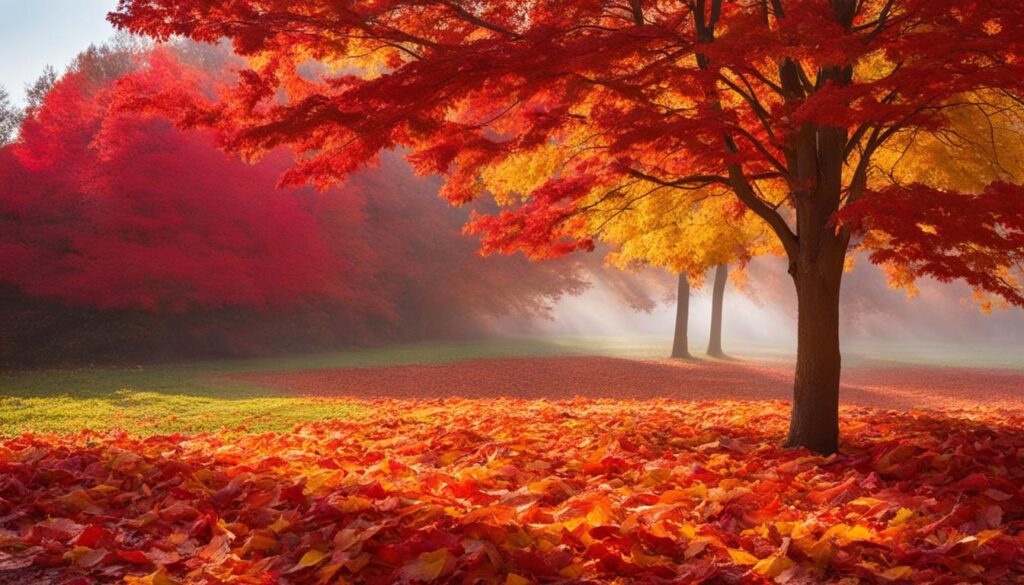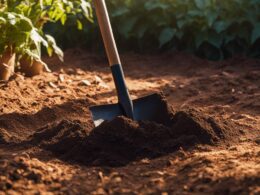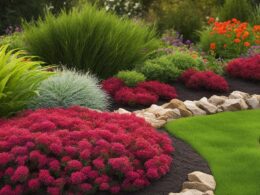Xeriscape gardening is a popular and environmentally friendly approach to landscaping, especially in dry climates. By incorporating leaf mulch into your xeriscape design, you can transform your landscape, save water, enrich the soil, and boost the health of your garden.
Key Takeaways:
- Leaf mulch is a valuable addition to xeriscape design.
- Using leaf mulch helps save water by retaining moisture in the soil.
- Leaf mulch enriches the soil as it decomposes, providing essential nutrients for plant growth.
- Incorporating leaf mulch suppresses weed growth, reducing the need for herbicides.
- Leaf mulch improves soil temperature regulation, protecting plants from extreme heat and cold.
The Principles Behind Xeriscape Design
Xeriscape design is based on seven fundamental principles: water conservation, soil improvement, limited turf area, use of native plants, mulch, irrigation, and maintenance. By adhering to these principles, you can create a sustainable and efficient xeriscape garden that thrives while minimizing water usage and maintenance efforts.
Water Conservation
One of the core principles of xeriscape design is water conservation. This involves selecting plants that are adapted to the local climate and require minimal irrigation. By choosing drought-tolerant species, you can significantly reduce the amount of water needed to sustain your garden. Additionally, proper planning and design techniques, such as grouping plants with similar water requirements and installing efficient irrigation systems, can further optimize water usage.
Soil Improvement
Improving the soil in a xeriscape garden is crucial for water retention and plant health. By increasing the organic matter content, the soil can hold more moisture and drain effectively. This can be achieved through the addition of compost, organic fertilizers, and other soil amendments. Implementing proper soil improvement techniques ensures that your plants have access to the nutrients and water they need to thrive.
Limited Turf Area
Xeriscape design promotes reducing the amount of turfgrass in your landscape. Turf areas require intensive irrigation and regular maintenance, making them water and labor-intensive. By limiting the turf area and replacing it with low-water-use alternatives such as groundcovers, native plants, or hardscapes, you can conserve water and reduce the need for constant upkeep.
Use of Native Plants
Utilizing native plants in your xeriscape design has numerous benefits. Native plants are naturally adapted to the local climate and soil conditions, making them more resilient and water-efficient. They require less fertilizer, pesticides, and water compared to non-native species. Additionally, native plants provide habitat and food sources for local wildlife, contributing to the overall biodiversity of your garden.
Mulch
Mulching is an essential component of xeriscape design. Applying mulch, such as organic leaf mulch, to the soil surface helps retain moisture, regulate soil temperature, suppress weeds, and improve soil fertility. Mulch acts as a protective layer that reduces evaporation and insulates the soil from extreme temperatures. It also decomposes over time, adding organic matter and nutrients to the soil.
Irrigation
Efficient irrigation is crucial in a xeriscape garden. Drip irrigation systems, soaker hoses, or other water-efficient methods should be used to deliver water directly to the plant roots while minimizing waste. By providing targeted irrigation, you can avoid overwatering and ensure that water is used effectively to support plant growth and minimize runoff.
Maintenance
Maintaining a xeriscape garden involves regular care and maintenance to ensure its long-term success. This includes proper pruning, weed control, and monitoring for pests and diseases. By staying proactive in maintenance efforts, you can address potential issues before they become more significant problems and ensure that your xeriscape garden remains healthy and vibrant.
| Principle | Description |
|---|---|
| Water Conservation | Select drought-tolerant plants and use efficient irrigation systems to minimize water usage. |
| Soil Improvement | Enhance the soil’s ability to store water and nutrients by increasing organic matter content. |
| Limited Turf Area | Reduce the amount of turfgrass to reduce water and maintenance requirements. |
| Use of Native Plants | Choose plants that are naturally adapted to the local climate and require less water and maintenance. |
| Mulch | Apply mulch to retain moisture, regulate soil temperature, suppress weeds, and improve soil fertility. |
| Irrigation | Use water-efficient methods such as drip irrigation to deliver water directly to plant roots. |
| Maintenance | Regularly prune, control weeds, and monitor for pests and diseases to keep the garden healthy. |
Table: Principles Behind Xeriscape Design and their Descriptions.
Overall Benefits of Xeriscape Gardening
Xeriscape gardening offers numerous benefits that make it an attractive and sustainable landscaping choice. By implementing water-conserving techniques and utilizing native plants, xeriscape gardens can help you save water, reduce maintenance efforts, increase property value, and create a habitat for local wildlife. Let’s explore these benefits in more detail:
Saving Water and Reducing Usage
One of the main advantages of xeriscape gardening is its ability to conserve water. Traditional gardening methods can result in excessive water consumption, especially in dry climates. Xeriscape gardens, on the other hand, are designed to minimize water usage by incorporating techniques such as efficient irrigation systems and plant selection. By reducing water usage by 50-75%, xeriscape gardens help conserve this precious resource and contribute to a more sustainable future.
Low Maintenance and Time/Cost Savings
Xeriscape gardens are known for their low maintenance requirements, making them an ideal choice for busy homeowners or those who prefer to spend less time on gardening chores. With careful planning and the use of mulch and native plants, xeriscape gardens can significantly reduce the need for watering, pruning, and weeding. This not only saves you time but also cuts down on maintenance costs and the use of chemicals and fertilizers.
Increased Property Value and Curb Appeal
Implementing xeriscape design in your landscape can enhance the visual appeal of your property and increase its value. Xeriscape gardens are known for their lush and vibrant appearance, showcasing a variety of native plants that are well-adapted to the local climate. The beauty and uniqueness of a well-maintained xeriscape garden can attract potential buyers and set your property apart from others in the neighborhood, resulting in a higher market value.
Wildlife Habitat and Environmental Benefits
Xeriscape gardens create a habitat for local wildlife, attracting birds, butterflies, and other beneficial insects. By incorporating native plants, you provide them with a food source and a safe haven. Xeriscape gardens also reduce the need for gas-powered equipment like lawn mowers, thus minimizing noise pollution and air pollution. These gardens are environmentally friendly and promote a healthier ecosystem.
In summary, xeriscape gardening offers a range of benefits, including water conservation, low maintenance, increased property value, wildlife habitat creation, pollution reduction, and time and cost savings. By embracing xeriscape principles and incorporating them into your own garden, you can create a beautiful and sustainable outdoor space that enhances your lifestyle and contributes to a greener future.
The Benefits of Leaf Mulch in Xeriscape Design
Leaf mulch plays a crucial role in xeriscape design, offering numerous benefits for water retention, temperature regulation, weed suppression, and soil enrichment. When incorporated into your xeriscape garden, leaf mulch acts as a natural barrier that retains moisture, reducing the need for frequent watering and conserving water resources. This is especially important in xeriscaping, where water conservation is a key principle. By helping the soil retain moisture, leaf mulch ensures that your plants have a stable and consistent water supply, even in dry climates.
In addition to water retention, leaf mulch also regulates soil temperature. It acts as an insulating layer, protecting the soil from extreme heat during the summer months, and maintaining warmer soil temperatures in winter. This temperature regulation is beneficial for plant growth and root development, ensuring that your xeriscape garden thrives throughout the year.
Another advantage of using leaf mulch in xeriscape design is its excellent weed suppression properties. The layer of mulch serves as a physical barrier that prevents weed seeds from germinating and reaching the soil surface. By suffocating weeds and blocking their access to sunlight, leaf mulch helps keep your xeriscape garden free of unwanted vegetation. This reduces the need for manual weeding or the use of chemical herbicides, promoting a more sustainable and eco-friendly approach to gardening.
| BENEFITS OF LEAF MULCH IN XERISCAPE DESIGN |
|---|
| Water Retention |
| Leaf mulch acts as a natural barrier that retains moisture, reducing the need for frequent watering and conserving water resources. |
| Temperature Regulation |
| Leaf mulch insulates the soil, protecting it from extreme temperatures and maintaining optimal conditions for plant growth. |
| Weed Suppression |
| Leaf mulch serves as a physical barrier that prevents weed seeds from germinating and reaching the soil surface. |
| Soil Enrichment |
| As leaf mulch decomposes, it releases nutrients into the soil, improving its structure and providing essential elements for plant growth. |
Lastly, leaf mulch contributes to soil enrichment as it decomposes over time. During the decomposition process, the mulch releases valuable nutrients into the soil, enriching its composition and fertility. This natural fertilization enhances the overall health and vitality of your xeriscape garden, providing essential nutrients for plant growth and development. The soil becomes more fertile and conducive to supporting a thriving ecosystem of plants and beneficial microorganisms.
In summary, leaf mulch is an indispensable component of xeriscape design, offering significant benefits for water retention, temperature regulation, weed suppression, and soil enrichment. By incorporating leaf mulch into your xeriscape garden, you can create a sustainable and thriving landscape that conserves water, supports healthy plant growth, and reduces the need for maintenance.
Using Fallen Leaves as Organic Compost and Mulch
Fallen leaves are a valuable resource that can be repurposed to benefit your garden in multiple ways. By using fallen leaves as organic compost and mulch, you can enhance soil enrichment, save money, and adopt an eco-friendly approach to gardening.
Organic compost created from fallen leaves is a natural and nutrient-rich fertilizer that can significantly improve soil quality. As the leaves break down, they release essential nutrients such as nitrogen, phosphorus, and potassium, which are vital for healthy plant growth. By incorporating this organic compost into your garden beds or mixing it with potting soil, you provide plants with a nutrient boost, leading to improved overall growth and productivity.
Using fallen leaves as organic mulch offers several advantages. When spread over the soil surface, mulch acts as a protective layer, preventing soil erosion, retaining moisture, and moderating soil temperature. This helps to create a favorable environment for plant roots and reduces the need for frequent watering. Additionally, organic mulch suppresses weed growth by blocking sunlight and inhibiting weed seed germination. By preventing weeds from establishing themselves, the mulch helps to maintain a clean and tidy garden bed.
| Benefits of Using Fallen Leaves as Organic Compost and Mulch | |
|---|---|
| Soil Enrichment | – Fallen leaves provide organic matter and essential nutrients, improving soil quality and fertility. |
| Money-Saving | – By utilizing fallen leaves, you can reduce the need for expensive fertilizers and mulches, saving on gardening expenses. |
| Eco-Friendly | – Repurposing fallen leaves as compost and mulch reduces landfill waste and promotes sustainable gardening practices. |
By harnessing the power of fallen leaves as organic compost and mulch, you not only optimize the health and productivity of your garden but also contribute to a more sustainable and environmentally friendly approach to gardening. So, the next time autumn leaves carpet your yard, consider collecting and using them to enrich your soil and create a thriving garden.
How Can Using Leaf Mulch in Xeriscape Design Unleash Potential?
In xeriscape design, the benefits of mulching strategies are amplified when using leaf mulch. This sustainable practice helps retain moisture, suppresses weeds, improves soil health, and adds nutrients. By incorporating leaf mulch, xeriscape designs can unleash their full potential, resulting in thriving, low-maintenance landscapes.
Conclusion
Leaf mulch is a crucial component of xeriscape design, offering a multitude of benefits for your garden and the environment. By incorporating leaf mulch into your xeriscape design, you can enjoy the advantages of water conservation, enhanced soil quality, weed suppression, and reduced maintenance efforts.
When you embrace leaf mulch in your xeriscape garden, you contribute to sustainable gardening practices and create a beautiful, environmentally friendly landscape. The use of leaf mulch conserves water by retaining moisture in the soil, reducing the need for frequent watering. It also enriches the soil as it decomposes, providing essential nutrients for your plants.
With the added advantage of using fallen leaves as organic compost or mulch, you can further enhance your garden’s growth and health. This cost-effective and sustainable solution not only enriches the soil but also reduces the need for chemical fertilizers and minimizes landfill waste.
In conclusion, by incorporating leaf mulch into your xeriscape design and utilizing fallen leaves as compost or mulch, you can create a sustainable garden that thrives while benefiting both your wallet and the environment.






